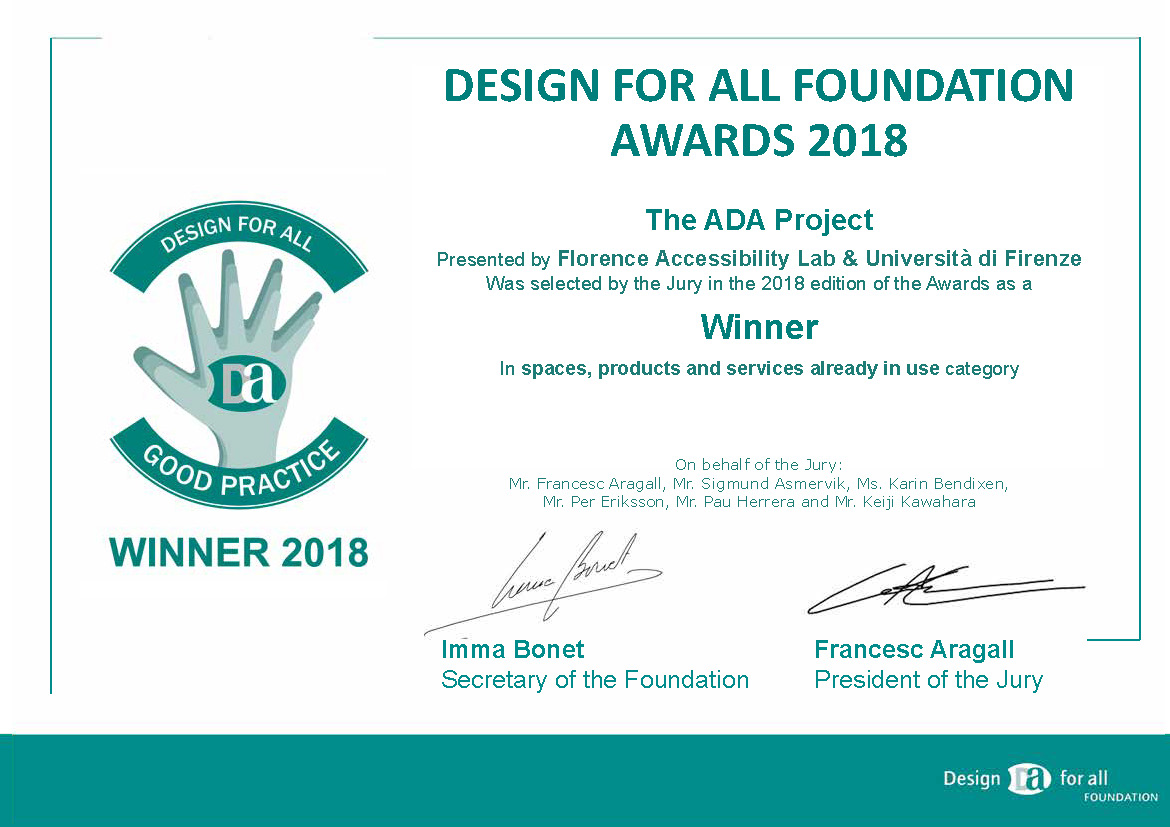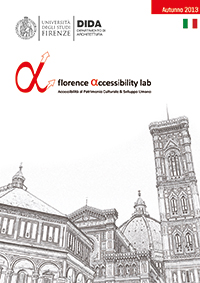|
The Interdepartmental Research Unit Florence Accessibility Lab originates with the purpose of defining, consolidating and promoting a new culture of accessibility; a culture that sees accessibility to the habitat as a great collective resource for the autonomy of people and for social inclusion, for offering more vitality, security and cohesion to local communities, for ascribing value -including tourism- to the architectural and landscape heritage, and for the development of state of the art technologies at the service of the inhabitants.
The Research Unit aims to become a point of reference for public, private and third sector entities in the fields of both basic and experimental research, of training and consulting on environmental accessibility for human development at the local level. Within the specific research field -cultural heritage- the Research Unit focuses its attention on the following topics:
- cultural districts
- natural parks and related areas
- urban areas
- archaeological areas
- state and public owned assets
- public buildings, or intended for public use
- consumer goods.

Objectives
The cultural vision of the Research Unity is based upon the central nature of the person in the processes of transformation of the habitat and in the need to guarantee that the said processes are guided by the understanding of the socio-economic dynamics and by a sense of care concerning the common assets, amongst which is clearly the cultural heritage. According to this point of view, the great paradigm of accessibility establishes as its horizon, and natural ethical, social and economic goal, the concept of Human Development as defined by the United Nations Development Programme (UNDP).
The aims of the Research Unit Florence Accessibility Lab are the following:
- to prove that accessibility is a particularly efficient way to activate and consolidate coherent, lasting and sustainable human development processes aimed at fostering healthy life-styles, to favour urban quality of life and safety, to elevate the 'social capital' of the community and to enhance local identity;
- to prove that accessibility can offer an added value to the architectural and landscape heritage of a region by making it not only more attractive and competitive for external visitors (accessible tourism), but also easier to enjoy for the locals;
- to promote social inclusion through accessibility planning and design at various scales;
- to propose solutions for ascribing value to local communities from the point of view of accessibility and socio-economic innovation;
- to design and carry out, together with small and medium-sized enterprises, systems, tools and technologies for environmental accessibility and awareness.

Recent research projects
2019|2020
“The Diaspora as a Resource for the Knowledge, Preservation and Enhancement of the Lesser Known Cultural Sites in Albania”
International Organisation for Migration (IOM)
Research Team: prof. Antonio Laurìa (FAL) (principal investigator), prof. Leonardo Chiesi (FAL), prof. Pietro Matracchi (FAL), prof. Ugo Tonietti.
2019
"La qualità acustica degli ambienti scolastici. Relazione tra percezione dei suoni e rendimento scolastico. Indagine finalizzata alla progettazione di un kit a supporto della correzione acustica delle aule"
Fondazione Cassa di Risparmio di Firenze - Manifattura Maiano
Research Team: prof. Simone Secchi (principal investigator), prof.ssa Lucia Bigozzi (FAL), prof. Antonio Laurìa (FAL).
2016-ongoing.
“The ADA Project. Home Adaptation for the Autonomy of severe disabled people”.
Agreement between Department of Architecture and the Tuscan Region. Principal investigator: prof. Antonio Laurìa
2015|2017
“Enhancing Abandoned Residual Spaces as an Opportunity for the Inclusive City. Pocket Parks for all”.
Strategic Project of Basic Research, 2014 (funded by University of Florence).Principal investigator: prof. Antonio Laurìa
2015|2016
Technical, scientific and research contributions to the activities of the Research Centre for Information and Documentation (CRID) of the Tuscan Region
Agreement between the Department of Architecture and the Tuscan Region (Consorzio Società della Salute Firenze Nord-Ovest).
Principal investigator: Prof. Antonio Laurìa"
2015|2016
Technical, scientific and research contributions to the activities of the Research Centre for Information and Documentation (CRID) of the Tuscan Region
Agreement between the Department of Architecture and the Tuscan Region (Consorzio Società della Salute Firenze Nord-Ovest).
Scientific Director: Prof. Antonio Laurìa"
2013|2015
DISCIT - Making persons with disabilities full citizens
European Commission - 7th Framework Programme - 7FP-SHH-2012-2-CP
NOVA (Norway) Referent PIN S.c.r.l.: Mario Biggeri (DISEI / FAL/ Unifi/)
discit.eu
2012|2013
Progetto T-VedO. 3-D reconstruction for blind audiences of pictorial works of art
P.A.R. FAS REGIONE TOSCANA Linea di Azione 1.1.a.3.
Coordinator: Monica Carfagni
www.t-vedo.net
2012|2013
Support tools for processes of urban regeneration and valorisation of the ex-railway districts of Borgo Verde and Borgo Nuovo in Pontassieve
RS Research Department of Architecture of the University of Florence/Municipality of Pontassieve
Coordinator: Leonardo Zaffi
2011|2012
Guidelines for the establishment of municipal building rules and regulations for improving the security of dwellings
Prevention of domestic injuries through good practices of building planning and design
Agreement between the Department of Technologies for Architecture and Design - TAeD and the Department for Prevention and Safety of the Tuscan Region
2011|2013
Space for rights. Interdisciplinary study for assessing spaces in hospitals
Funds FAS Regione Toscana, Department of Economic Law, University of Florence
Coordinator: Leonardo Chiesi
www.rightspaces.eu

Recent publications
A. Laurìa, B. Benesperi, P. Costa & F. Valli - in press - DESIGNING
AUTONOMY AT HOME. The ADA Project: An Interdisciplinary Strategy for Adaptation of the Homes of Disabled Persons, Firenze: FUP
P. Mori, J. Sforzi (eds), 2018, Imprese di Comunità - Innovazione istituzionale, partecipazione e sviluppo locale, Bologna: Il Mulino.
Lauria, A., Secchi, S., Vessella, L. (2018). Visual wayfinding for partially sighted pedestrians – The use of luminance contrast in outdoor pavings. Lighting Research & Technology, pp. 1-19
Buonamici, F., Furferi, R., Governi, L., Puggelli, L., Volpe, Y. (2018). Tactile reproduction of paintings: the experience of the Department of Industrial Engineering of Florence. IOP Conference Series: Materials Science and Engineering, vol. 364, pp. 1-10
R. Halvorsen, B. Hvinden, J. Beadle Brown, M. Biggeri, J. Tøssebro & A. Waldschmidt (Eds) (2017) Understanding the Lived Experiences of Persons with Disabilities in Nine CountriesActive Citizenship and Disability in Europe, Volume 2, London: Routledge.
Laurìa, A., Benesperi, B., Costa, P & Valli, F. (2017). Il Progetto ADA. Un modello di intervento per l'autonomia domestica delle persone disabili, Milano: Franco Angeli
Lauria, A. (2017). Tactile Pavings and Urban Places of Cultural Interest: A Study on Detectability of Contrasting Walking Surface Materials. The Journal of Urban Technology, 24, (1): 3-33
Lauria, A. (a cura di) (2017). Piccoli Spazi Urbani. Valorizzazione degli spazi residuali e qualità sociale. Napoli: Liguori, pp. 1-372.
Buonamici, F., Carfagni, M., Furferi, R., Governi, L., Volpe, Y. (2016). Are We Ready to Build a System for Assisting Blind People in Tactile Exploration of Bas-Reliefs?. Sensors, - Special Issue Imaging: Sensors and Technologies, 16(9): 1-16
Lauria A. (2016). "The Florence Experience": A multimedia and multisensory guidebook for cultural towns inspired by Universal Design approach. WORK, 53 (4): 709-727. ISSN:1051-9815
"Arenghi A., Garofolo I., Lauria A. (2015). Accessibility as a design
resource for the enhancement of lesser-known cultural sites from the
perspective of tourism. In: Crisan R., Fiorani D., Kealy L., Musso S.F.
(editors). Conservation reconstruction. Small historic centres
conservation in the midst of change, pp. 409-415, Hasselt: EAAE,
ISBN:978-2-930301-63-1"
Lauria A.(2014). Accessibility as a “Key Enabling Knowledge” to Human Development: the Accessibility Plan. TECHNE, vol. 7, pp. 125-131
Garofolo I., Lauria A., Grion S. (2014). Developing Accessibility Plans: Methods and Tools. Case study. In Caltenco H., Hedvall P-O., Larsson A., Rassmus-Gröhn K., Rydeman B. (EDS) Universal Design 2014: Three Days of Creativity and Diversity, Lund, Sweden, June 16-18, 2014, IOS Press, vol. 35, pp. 79-88.
Mori P. (2014), “Community and Cooperation: the Evolution of Cooperatives towards New Models of Citizens’ Democratic Participation in Public Services Provision”, Euricse Working Paper n. 63 | 14, (in process of being published by: Annals of Public and Cooperative Economics).
Lauria A. (ed.) (2012) I Piani per l'Accessibilità. Una sfida per promuovere l'autonomia dei cittadini e valorizzare i luoghi dell'abitare. Roma: Gangemi Editore.
%2C%20Francesc%20Aragal%20(Presidente%20della%20Design%20for%20All%20Foundation)%20e%20Andrea%20Valdre%CC%80%20(Regione%20Toscana).jpg)
|
Coordinator
Antonio Laurìa Department of Architecture
Composition of the research unit
DIDA
Department of Architecture
Dimitra Barbalis
Stefano Bertocci
Antonio Capestro
Stefano Carrer
Giuseppe De Luca
Luca Giorgi
Antonio Laurìa
Pietro Matracchi
Leonardo Zaffi
DIEF
Department of
Industrial Engineering
Benedetto Allotta
Monica Carfagni
Lapo Governi
DSPS
Department of
Political and Social Sciences
Leonardo Chiesi
Giovanni Scotto
DISEI
Department of
Economy and Business
Luca Bagnoli
Marco Biggeri
Mauro Lombardi
Pier Angelo Mori
SCIFOPSI
Department of Education and Psychology
Lucia Bigozzi
|




%2C%20Francesc%20Aragal%20(Presidente%20della%20Design%20for%20All%20Foundation)%20e%20Andrea%20Valdre%CC%80%20(Regione%20Toscana).jpg)


